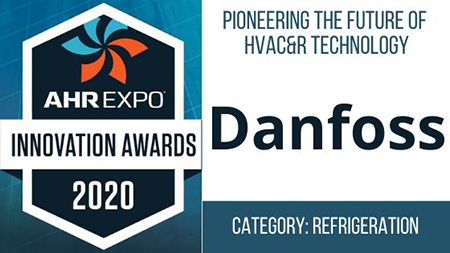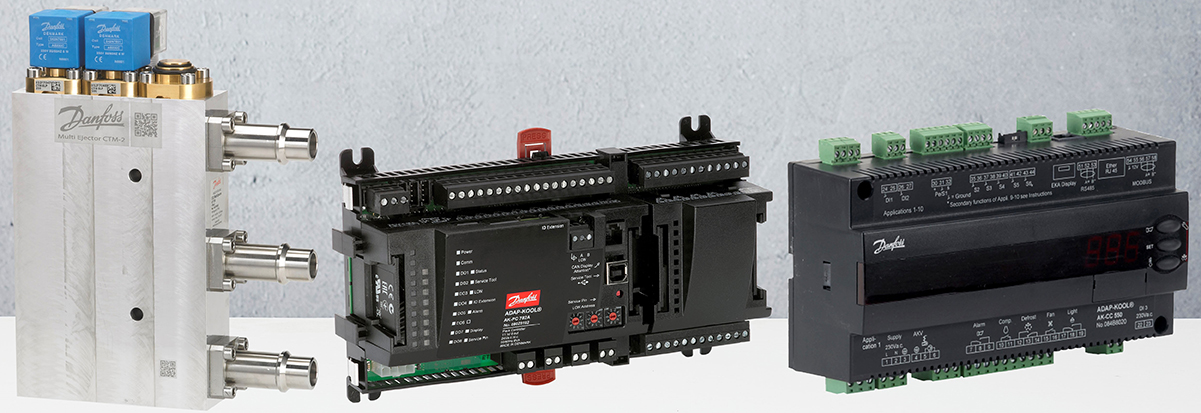
Product of the Year

Two Technologies Ease Industry Transition to Alternative Refrigerants
Danfoss has developed a solution to help the HVAC&R industry transition to more environmentally friendly, efficient refrigerants.
Danfoss’ (Booth 1501) CO2 Adaptive Liquid Management (CALM) solution—the winner of the 2020 AHR Expo Innovation Awards’ refrigeration category—combines Danfoss’ liquid ejector and adaptive liquid control case controller algorithm to fully utilize the evaporator surface in display cases and cold rooms. This provides up to 10% greater energy efficiency in addition to the energy savings inherent in CO2 refrigeration.
The product improves energy efficiency and helps food retailers confidently transition to CO2 refrigeration, said Jim Knudsen, a North America food retail segment leader for Danfoss.
“As refrigerant regulations evolve and the consequences of climate change become increasingly clear, market decisions to transition to climate-friendly refrigerants are becoming a top priority around the world,” he said. “With thousands of CO2 refrigeration installations globally, Danfoss is helping customers make this transition today—while saving energy, maintaining system reliability and ensuring food safety.”
The CALM system is focused on food retail applications and allows users to use energy-efficient, climate-friendly and future-proof transcritical CO2 refrigeration systems, said Knudsen, adding these systems operate more efficiently than traditional hydrofluorocarbon (HFC) systems in any climate.

“The advantages of the CO2 Adaptive Liquid Management Solution can be applied to small and large CO2 systems in all climates,” he said.
The system also reduces first-time investments. With less liquid in the suction line, the size of the suction accumulator can be reduced, said Knudsen. Required compressor capacity can also be reduced, which allows Danfoss to use smaller or fewer compressors in the product. Knudsen said CALM is a complete solution that includes an intelligent system manager, dedicated control devices for the refrigeration rack (pack controller), display cases and evaporators (case controllers).
Meet the Innovations
The system incorporates two “ground-breaking” Danfoss innovations: the ALC case controller algorithm and the liquid ejector, according to Knudsen.
“The ALC case controller algorithm causes the injection of an excess of refrigerant into the evaporators, increasing evaporation temperature and decreasing superheat to close to zero. This proprietary ALC algorithm ensures maximum effective use of the evaporators while minimizing excess liquid passing through the evaporators to a small suction accumulator,” he said.
The ALC algorithm builds on more than 80 years of experience of Danfoss’ efficient evaporator control, said Knudsen. This in-depth knowledge allowed Danfoss to create a control that injects just enough refrigerant to achieve optimal efficiency while not allowing massive amounts of liquid refrigerant to accumulate at any point in the system.
The liquid ejector uses transcritical expansion energy to efficiently remove liquid for the suction accumulator and then return it to the liquid receiver to be used again.
“This allows the suction accumulator to protect the compressors and requires no additional energy use. Together, these components optimize evaporator performance, increase suction pressure and decrease compressor energy consumption,” Knudsen said.
Knudsen said the liquid multi-ejector is a solid-state device that utilizes work that would otherwise be lost in the system to pump the excess liquid back through the system—such protecting compressors against flow-back without adding to the energy used in the system.
The CALM solution increases the evaporating temperature to increase suction pressure, he said. This reduces both the load on the compressor and energy consumption.
“The ALC algorithm can typically achieve energy savings 5% better than minimum competitive active superheat management systems and 10% better than fixed superheat solutions,” he said.
For additional coverage of AHR Expo, visit ASHRAE Journal’s AHR Today web page.